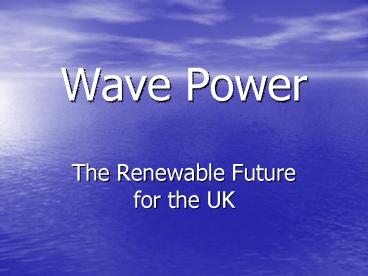Wave Power PowerPoint PPT Presentation
1 / 18
Title: Wave Power
1
Wave Power
- The Renewable Future for the UK
2
Wave Power
- Waves are created by interaction with wind on the
surface of the water. - The wind blows across the Atlantic Ocean all the
way from America. - This large distance means the UK has one of the
highest wave power levels in the world.
3
Wave Power - The Resource
European Wave Resource Chart The chart shows
annual average wave power in kilowatts per metre
of crest width for various European sites. (Ocean
Power Delivery Limited, 2005)
4
Wave Power The Potential
- There is sufficient energy breaking on the UK
shoreline to power the country three times over. - However, it is not practical to recover all the
energy. - The economically recoverable resource for the UK
has been estimated to be 87 TWh/y-1.
5
Wave Power The Technology
- There are two major areas of wave power
- Shore-line
- Offshore
- The wave industry has many technologies striving
for success, very few will, however, eventually
achieve commercialisation.
6
Wave Power The Devices
There are two current potential commercial
technologies. One is shoreline and the other is
offshore.
- The Limpet - Wavegen (Shoreline)
- The Pelamis - OPD (Offshore)
7
Wave Power The Technology
- Pelamis has a generating capacity of 750 kW
- The Pelamis is a semi-submerged structure.
Wave-induced motion of hinged joints is resisted
by hydraulic rams. This pumps oil through
hydraulic motors which drive electrical
generators giving electricity.
- Limpet has a generating capacity of 500 kW and
currently powers 300 homes in Islay. - Limpet uses the Oscillating Water Column
Technology. This relies on the motion of the
waves compressing and sucking air through a
turbine which powers a generator.
8
Wave Power The PredictionsOFFSHORE
- The Pelamis will not be ready to go commercial
for another 5 years from present.
- Due to this the prediction for offshore is
- 0 PJ
2010
9
Wave Power The PredictionsOFFSHORE
- Due to scale of Pelamis I predict there will be a
yearly build rate of 200 devices each taking 3
months to build. - Load factor will be less than wind 0.2
- This is generation in 5 years-
- 200 x 750 150 000 kW
- 150 000 x 0.2 x 8736
- 262 080 000 kWh x 5
- 1 310 400 000 / 1000
- 1 310 400 MWh/y-1
- Or
- 4.72 PJ
2015
10
Wave Power The PredictionsOFFSHORE
- I predict that in 5 years from the initial phase
of commercialisation the amount of energy
generated will double due to and increase in the
number of wave farms
- 2000 devices deployed
- 1 310 400 1 310 400
- 2 620 800 MWh/y-1
- Or
- 9.43 PJ
2020
11
Wave Power The PredictionsOFFSHORE
- 3000 devices deployed
- 1 310 400 x 3
- 3 931 200 MWh/y-1
- Or
- 14.15 PJ
- 4000 devices deployed
- 1 310 400 x 4
- 5 241 600
- Or
- 18.87 PJ
- Again I believe that in 2025 and 2030 the
industry will remain at a constant increase as
although manufacture may improve the number of
suitable locations may decrease due to adverse
effects on shipping and other activities.
2025 2030
12
Wave Power The PredictionsOFFSHORE
- The energy consumption for the UK is 10500 PJ per
year. - With Offshore Wave power producing 18.87 PJ
It would therefore be able to contribute 0.17
of the UK's needs.
13
Wave Power The PredictionsSHORELINE
- These devices again are unlikely to be fully
commercial until after 2010 - The prediction is 0MW.
2010
14
Wave Power The PredictionsSHORELINE
Scottish coastline length 16,491 km Spacing of
devices 1 device 1 km
- The major constraint for this type of shore
based technology is location. - These devices can only be built into hard rock.
The South and the East coastlines, excluding
Cornwall, are therefore not ideal. - Pembrokeshire and West Scotland are good
locations.
Build scale of around 30 per year This would
take up 30 km/y-1
A maximum number of devices is 16, 491.
- 10 of coastline is probably optimal.
- This is equal to 1649 devices
30 devices every year for 20 years 600 devices
by 2030
15
Wave Power The PredictionsSHORELINE
- 600 x 500
- 300000kW/1000
- 300 MW
- 300 x 0.2 x 8736
- 524160 MWh/y-1
- 1.89 PJ
- This works out at
- 0.0179
- of the UKs demand
- By 2030 the Onshore wave industry will be
generating 0.0001456 PJ - As discussed earlier the major limiting factor
for this technology is space. - Large opposition would be created if it was
proposed to put wave plants every 100 m along the
coast. - This wave plant also has a lower load factor than
wind.
2030
16
Wave Power The PredictionsTogether
- Together Offshore wave and onshore wave can
produce 20.76 PJ by 2030. - This works out at
- 0.2 of the UKs energy demand
2030
17
Wave Power - Major Restrictions
- Costs
- Competition with lower cost technologies.
- Technology
- Force of the sea (Osprey)
- Transmission
- Fewer potential sites
- Higher installation costs
- Individual projects (economies of scale)
18
Wave Power
- The Renewable Future for the UK
THE END

